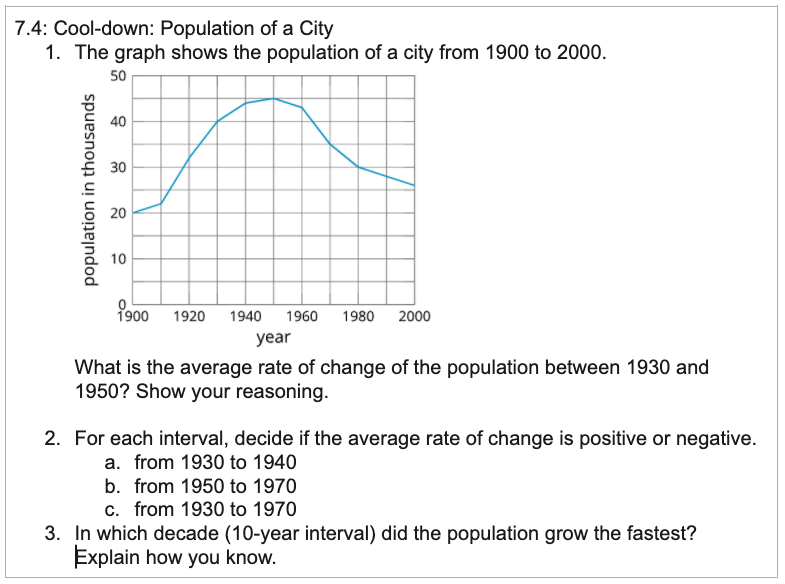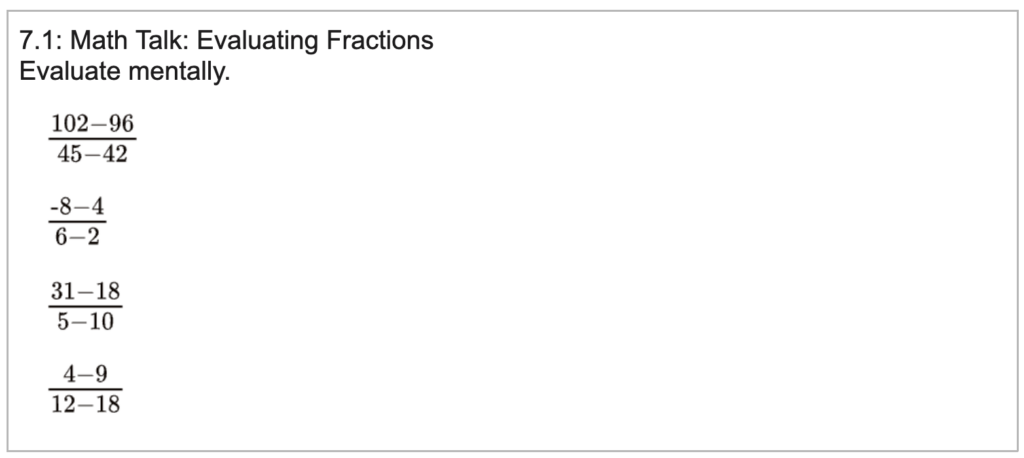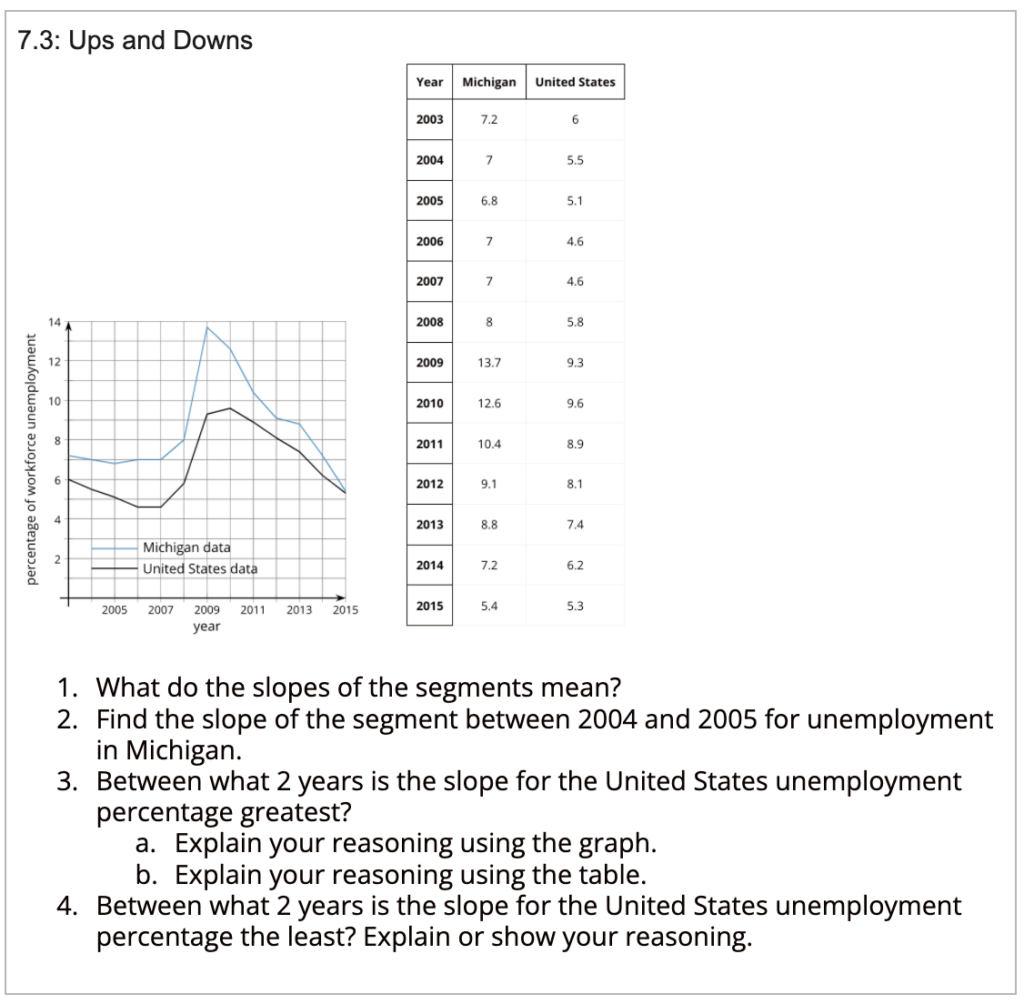By IM Professional Learning Team
How do we attend to unfinished teaching and learning, while attending to grade-level expectations?
Algebra 1 is often called a “gatekeeper.” Successful completion of Algebra 1 unlocks options for students on the road to becoming college- and career-ready. Ensuring all students have this opportunity requires a flexible approach to instruction that makes space for both access and challenge. For challenge, every lesson in IM 9–12 Math offers students an Are you ready for more? prompt, designed to give students space to delve deeper into an idea from the lesson. For access, there are supports embedded in the curriculum. Specifically for Algebra 1, IM designed Algebra 1 Support Materials to give students space to engage with prerequisites that are in play within the corresponding Algebra 1 course lesson.
One recommendation from the Council of Great City Schools’ Addressing Unfinished Learning After COVID-19 School Closures document, released June 2020, is to “keep the focus on grade-level content and rigor, addressing learning gaps as needed within the context of grade-level work.” Each Algebra 1 Extra Support lesson is paired with a grade-level Algebra 1 lesson and is designed to be encountered first, to give students an opportunity to engage with prerequisite topics to have a greater chance at success in the corresponding Algebra 1 lesson.
About Algebra 1 Extra Support Materials
The structure of the Extra Support lessons is similar to that of all the Illustrative Mathematics lessons. Each Extra Support lesson contains a warm-up focused on sense-making or procedural fluency, followed by exactly two classroom activities. Loosely, the first activity is intended to help students remember a concept and any associated terms, procedures, or skills, and the second activity is intended to provide students an opportunity to practice. Digital tools are incorporated in the same way.
Examining an Algebra 1 Lesson
Let’s examine one example of an Algebra 1 lesson before exploring the supporting materials that enhance access. The course-level lesson we’ll look at is from Algebra 1 Unit 4: Functions, specifically Lesson 7: Using Graphs to Find Average Rate of Change.
In looking at the lesson learning goals, we see that student understanding of slope is a prerequisite.
- Given a graph of a function, estimate or calculate the average rate of change over a specified interval.
- Recognize that the slope of a line joining two points on a graph of a function is the average rate of change.
- Understand that the average rate of change describes how fast the output of a function changes for every unit of change in the input.
A look at the lesson cool-down illustrates how students will apply their understanding of average rate of change by the end of the lesson.

The activities in this lesson introduce students to the concept of average rate of change. They build on what students know about rate of change and slope. Students might see that finding the average change in the output per unit of change in the input can be a useful way to generalize what happens between two function values, regardless of the behaviors of individual data points between them.
This activity, “Drop Some More,” presents the data in two forms: as a table and as a graph. Which representation might students prefer? How might students’ knowledge of slope influence their choice?

In the last instructional activity of the lesson, students have an opportunity to practice finding and interpreting average rates of change in a different context. This activity and the cool-down offer only a graph, and not a table of values, so students will need to estimate the coordinates on the graph to compute the average rates of change. They will need to attend to the units used to measure the input (x-axis) and output (y-axis).
From reflecting on the intended focus of these tasks and how they build on each other, we recognize how having prior knowledge of slope will help keep the cognitive focus on these other aspects of average rate of change. If one finds that student knowledge of slope is at an emerging stage, Algebra 1 Extra Supports materials can be used to ramp students into course-level work.
Examining the Extra Supports Lesson
The structure of the Extra Supports lesson mirrors that of the course lesson. Each Extra Supports lesson has a warm-up followed by two instructional activities, each activity with an activity synthesis.
The Algebra 1 Extra Supports lesson that corresponds to the Algebra 1 lesson above (“Using Graphs to Find an Average Rate of Change”) is called “Segments of Slopes.” In it, students work with shorter rates of change and slopes. Let’s look at how the corresponding Algebra 1 Extra Supports lesson is structured to ramp students into course-level work.
The lesson opens with a Math Talk designed to elicit strategies and understandings students have for subtracting and dividing. These understandings help students develop fluency and will be helpful later in this lesson when students will need to be able to find the slope of the line through 2 given points.

In the activity that follows, students find the slope of a line that goes through 2 given points. By finding a slope using 2 coordinate pairs, students are focusing on the mechanics of computing the value and can focus more fully on the context and meaning in the Algebra 1 lesson, in which they are finding the average rate of change over an interval.

In the final instructional activity, students consider the slope of segments in a situation. They interpret the meaning of slope in the situation, then find the segments where the slope is greatest and least. In the associated Algebra 1 lesson, students examine the average rate of change in situations.

The work of this Extra Supports activity gives students access to the Algebra 1 lesson by allowing them to consider only segments between two connected points so they can focus on average trends in the Algebra 1 lesson.
And collectively the work in this lesson gives students these inroads, while making space for students to engage in the rhythms of a problem-based classroom.
Algebra 1 Extra Supports in Action
We reached out to representatives from districts using these materials and learned of a couple of models in play, as well as considerations for each. What follows is a description of the different models.
Model 1
In Model 1, select students are enrolled in two math classes: an Algebra 1 course and an Algebra 1 Supports class, with the IM Algebra 1 Extra Supports as the curriculum. Students have the same instructor for both blocks to ensure alignment between the courses. Using the sample lessons from above, students would engage with Algebra 1 Supports Unit 4 Lesson 7: Slopes of Segments prior to engaging with Algebra 1 Unit 4 Lesson 7: Using Graphs to Find Average Rate of Change.
Teachers using this model have reported students enrolled in the Supports course have demonstrated a greater level of engagement, confidence, and performance in the grade-level course than previously seen.
Teachers and site leads share efforts to ensure heterogeneous groups within the course-level classes, meaning the course-level Algebra 1 classes host students enrolled in the Algebra 1 Supports class, as well as students who are strictly at course level, as they recognize one drawback of this model is that students enrolled in two math classes must give up an elective. Multiple measures are used to identify students for a second math class, measures such as state assessment results and teacher recommendations.
Model 2
In a Model 2, district leads used IM Curriculum Adaptation Packs and Pre-Unit Diagnostic Assessments to identify key instructional lessons within each unit in the grade-level Algebra 1 course. This method would have led the team to identify Lesson 7 within Unit 4 as a key lesson in which to ramp students into grade-level work using the Supports materials. This model is designed to address unfinished teaching and learning within the context of the grade-level course.
With this model, teachers may elect to use Activity 7.2: Connect the Dots from the Algebra 1 Supports course material within the context of course-level Lesson 7. One option could be to insert Activity 7.2: Connect the Dots after the warm-up 7.1: Temperature Drop. The drawback to this model is that by including an additional instructional activity in any given lesson, one may need to deemphasize or completely eliminate an instructional activity from the grade-level lesson.
Next Steps
We’re curious to learn how you are addressing learning needs within the context of grade-level work and what factors you take into consideration. Please share in the comments below.
